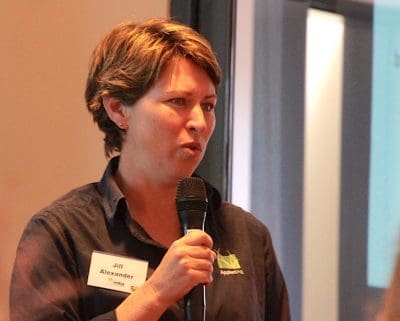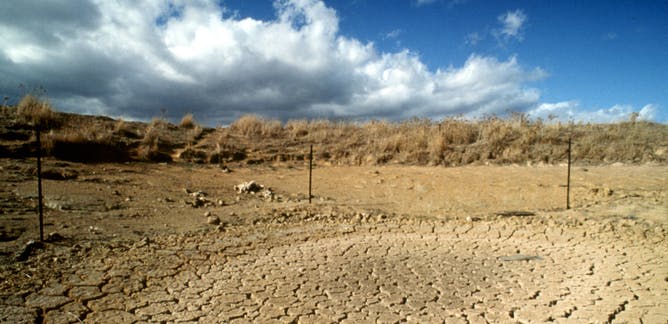THE story of the boiling frog is a 19th century fable that suggests a frog placed suddenly in boiling water will jump out, but a frog placed in a pot of cold water which is then gradually heated will not perceive the danger and will slowly boil to death.
 Sad for the frog, but, as grazing land management trainer and consultant Jill Alexander explained at an MLA BeefUp forum at Miles this week, also a useful metaphor for the gradual but sinister seasonal slide that can lead to severe drought conditions, as many are now experiencing.
Sad for the frog, but, as grazing land management trainer and consultant Jill Alexander explained at an MLA BeefUp forum at Miles this week, also a useful metaphor for the gradual but sinister seasonal slide that can lead to severe drought conditions, as many are now experiencing.
The most devasting years of the Federation Drought in 1902/03 were preceded by several years where rainfall was either below average or average at best.
As with many droughts, conditions became a bit drier and a bit drier before landholders were whacked with the driest year on record in many places.
“Sometimes, as we have a run of dry years, it seems to be the way that we keep hoping and keep hoping it is going to rain, and we don’t make decisions early enough,” Mrs Alexander said.
No one can know for sure how seasonal conditions will play out, but they can make make good early decisions by looking at broad pasture growth patterns to identify three key decision dates for their location.
In northern Australia for example the bulk of growth of tropical pasures happens during the warmest months of the year and most rapidly in summer when the bulk of rain falls. The rest of the year producers are managing a standing haystack which gradually deteriorates in nutritional value, Mrs Alexander explained. Autumn and winter rain will initiate the growth of herbage which improves the quality of feed on offer during this time, but comparatively low quantity on a dry matter basis.
Given this pattern of growth, she said there were three key decision dates producers can use to review paddock and animal conditions and to make early stocking decisions for their district.
Using the example of Miles where Wednesday’s BeefUp forum was held, she said the three dates would be:
The first decision date is mid-way through the growing season which in Southern Queensland is early January,
“By this time if you haven’t had a break in the season you know that it is unlikely you will be able to grow the bulk feed that you would have if you had an earlier start to the season because reducing temperature and a dwindling pool of plant available nutrients will start to rapidly slow down growth as Autumn progresses,” she said.
“This is an early opportunity to offload excess stock while the market is usually still strong.’
The second key decision date is the end of the growing season – mid-April in the case of Miles – when tropical pasture grasses have moved into a dormant phase and the bulk pasture on hand is your feedbase until the next growing season.
This was the time to do a dry season forage budget, looking at whether you have enough feed in the paddock to meet the needs of the stock you have on hand. “This is your second opportunity to adjust stock numbers to match the feed supply while they still have good body condition”.
The third key decision date is mid-way through the dry season, early July in Southern Qld. This is a time to review the pasture condition and the season to date.
“Particular attention should be paid to pasture quality to determine if supplementary feed is needed to meet the production targets of different classes of animals on the property. If there hasn’t been any winter rain, it is likely stock will be rapidly losing weight by now. If there is good winter herbage there may be no need to use supplements.”
 Mrs Alexander said she heard a regional mayor in a media interview recently state that producers could not be expected to know when to reduce stock numbers.
Mrs Alexander said she heard a regional mayor in a media interview recently state that producers could not be expected to know when to reduce stock numbers.
She said that was not the case, and regular monitoring would help producers to make earlier decisions.
Her advice was for producers to maintain grasscover to ensure their land was always “rain ready”. She said veteran rangelands scientist Dr Bill Burrows advice on his retirement was that regardles of what grazing system a producer used or how they managed their country, if they came out of a dry spell with good pasture stublle in their paddock, that was a sign that had probably managed their grazing pressure about right.
“So it is not about the system you’re using, it is about stocking rate mamangement,” she said. “We found through MLA funded grazing systems trials in the early late 2000s looking at which grazing system had the best impact on land condition and animal performance, that the over riding result from that trial was that it wasn’t the system, it was stocking rate management.
“Timing off spelling and stocking rate managment was the biggest driver of pasture and animal productivity.”
Producers were also urged to maintain a level of flexibility in their herd structure and grazing management system to allow for adjustment of stock numbers as required. “If you do have a core breeding herd make the herd size something that you can sustain seven out of 10 years as opposed to five out of 10 years, and then look at opportunities in those years that you have more feed.”
Another key message was not to rush in and hammer new season pasture growth too quickly after rain. Most damage was done to pastures early in the growing season, not in the dry.
“This is actually when a lot of the land condition decline happens, when the season breaks, not during the drought,” she said.
“I know everyone wants to get back to full production, but the more you hold off early in the growing season, the qucker you will get back to full production,” she said.
Mrs Alexander worked as a pasture agronomist for Queensland’s Department of Primary Industries throughout the State for 13 years before starting her own business Applied Ag in 2011, through which she works with private landholders, pastoral companies and Government organisations in the area of grazing land management. She recently finished reviewing and re-writing the Grazing Land Management EDGE training workshops, and coached one of MLA’s national pilot Profitable Grazing Systems groups.


Great article – I think the ‘boiling frog’ is a great analogy. It also holds for the slide in land condition and the decline in productivity with time if stocking rates are not being managed as the seasons change. All of which just accelerates a vicious circle of overgrazing and further loss of land condition.
One problem is that there are many many different country types out there, and there is no one size fits all way to make decisions.
If we take Central and Northern Queensland, a property owner with say prime brigalow buffel land around Rolleston is going to have to have a different pasture management plan then someone along the coast with forest black speargrass country.
I agree 100% that pasture management is the key to success and that graziers need to think of themselves as growing grass, not growing cattle. Unfortunately there are still plenty of places out there where the owners seem to really hate grass, as they never have any. Although their dams are always full.
Right on the money Jill – well done.
Very important article, especially for northern Australia.